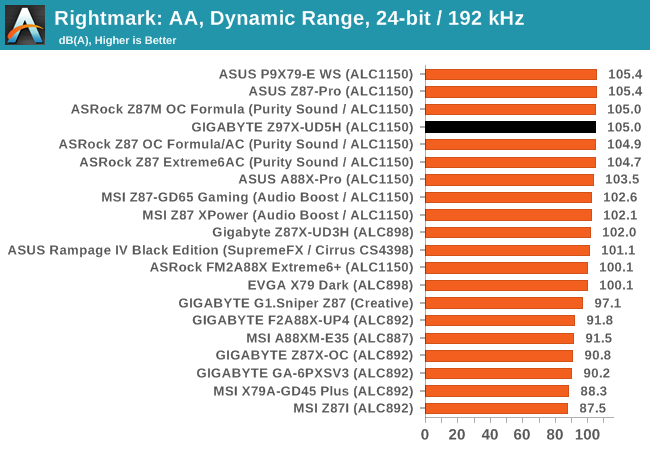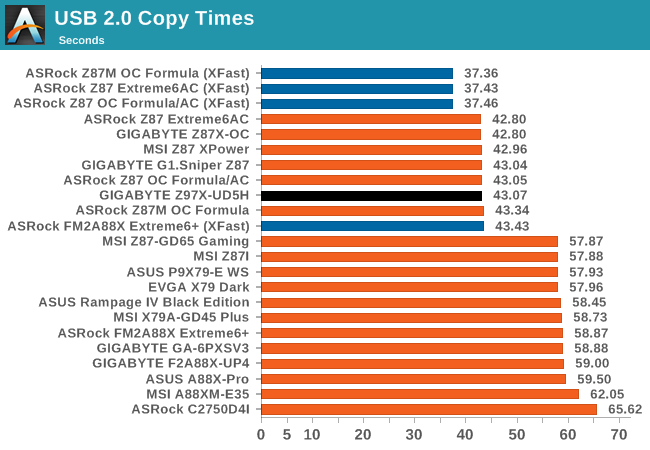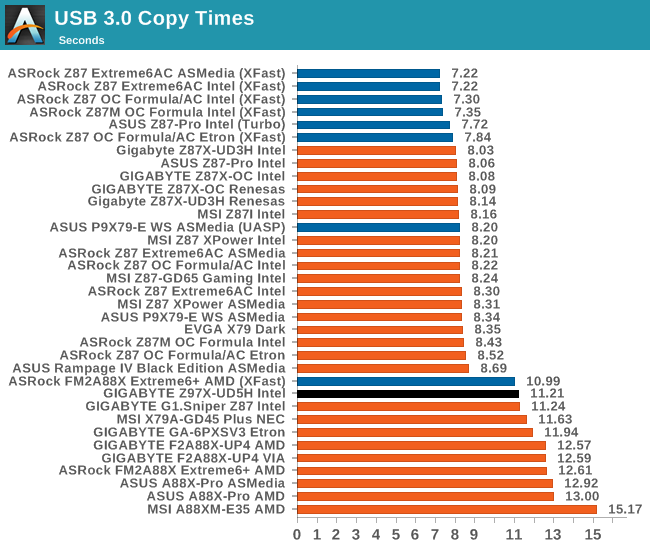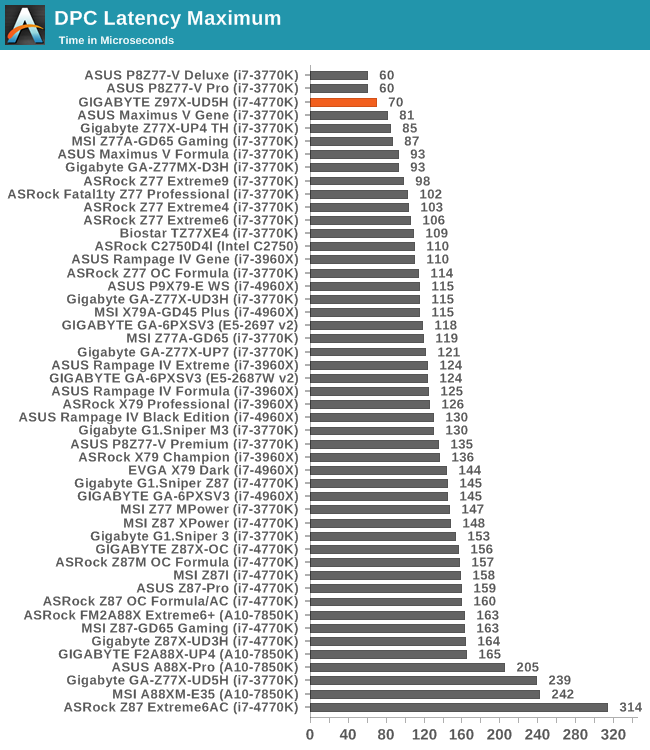GIGABYTE Z97X-UD5H Review: Choose Your Storage Option
by Ian Cutress on May 14, 2014 9:00 AM EST- Posted in
- Motherboards
- Intel
- Gigabyte
- Z97
System Benchmarks
Rightmark Audio Analyzer 6.2.5
The premise behind Rightmark:AA is to test the input and output of the audio system to determine noise levels, range, harmonic distortion, stereo crosstalk and so forth. Rightmark:AA should indicate how well the sound system is built and isolated from electrical interference (either internally or externally). For this test we connect the Line Out to the Line In using a short six inch 3.5mm to 3.5mm high-quality jack, turn the OS speaker volume to 100%, and run the Rightmark default test suite at 192 kHz, 24-bit. The OS is tuned to 192 kHz/24-bit input and output, and the Line-In volume is adjusted until we have the best RMAA value in the mini-pretest. We look specifically at the Dynamic Range of the audio codec used on board, as well as the Total Harmonic Distortion + Noise.
Dynamic Range of the Z97X-UD5H


While the dynamic range of the UD5H was good, the THD+N was low - this is indicative of a driver issue we encountered. Not unique to the UD5H, but the disk drivers we were provided causes a lot of distortion at 100% speaker volume. On other motherboards with the same codec, an audio driver update fixed the issue, and we assume it will be similar for the UD5H.
USB Backup
For this benchmark, we run CrystalDiskMark to determine the ideal sequential read and write speeds for the USB port using our 240 GB OCZ Vertex3 SSD with a SATA 6 Gbps to USB 3.0 converter. Then we transfer a set size of files from the SSD to the USB drive using DiskBench, which monitors the time taken to transfer. The files transferred are a 1.52 GB set of 2867 files across 320 folders – 95% of these files are small typical website files, and the rest (90% of the size) are the videos used in the WinRAR test. In an update to pre-Z87 testing, we also run MaxCPU to load up one of the threads during the test which improves general performance up to 15% by causing all the internal pathways to run at full speed.


DPC Latency
Deferred Procedure Call latency is a way in which Windows handles interrupt servicing. In order to wait for a processor to acknowledge the request, the system will queue all interrupt requests by priority. Critical interrupts will be handled as soon as possible, whereas lesser priority requests, such as audio, will be further down the line. So if the audio device requires data, it will have to wait until the request is processed before the buffer is filled. If the device drivers of higher priority components in a system are poorly implemented, this can cause delays in request scheduling and process time, resulting in an empty audio buffer – this leads to characteristic audible pauses, pops and clicks. Having a bigger buffer and correctly implemented system drivers obviously helps in this regard. The DPC latency checker measures how much time is processing DPCs from driver invocation – the lower the value will result in better audio transfer at smaller buffer sizes. Results are measured in microseconds and taken as the peak latency while cycling through a series of short HD videos - less than 500 microseconds usually gets the green light, but the lower the better.

Hurrah, it looks like the DPC Latency issues around Z87 are gone! With Z87, every motherboard we tested was >140 microseconds on DPC Latency, but it looks like Z97 is going straight to the top of our testing. Other motherboards we are currently testing show similar results at the top end of our results.











53 Comments
View All Comments
Ian Cutress - Wednesday, May 14, 2014 - link
At this point, it is more up to the motherboard manufacturer and what they implement.The chipset diagrams will show you how the slots are arranged, and which can be used at the expense of others. We will try and add these as we go forward.
As for protocols, it is all AHCI right now.
Jon-Tech - Wednesday, May 14, 2014 - link
I wanted to ask about USB controllers. Are all the USB 2.0 ports using one controller? Are the USB 3.0 ports on the same controller? Also from the sounds of it, the extra USB 3.0 ports are just using a hub rather than an extra controller? Due to my setup I often run into USB bandwidth issues with lots of ports on one controller. So I'm looking at motherboards that have as many as possible for more flexibility and none of the review sites ever seem to mention how many there are!Regarding the z97 chipset, it appears that the xHCI Host Controller supports up to 6 USB 3.0 and 14 USB 2.0, this sounds like one controller. It also has two EHCI Host Controllers which support up to 14 external USB 2.0, though it doesn't look like any of the motherboards are using these. From the sounds of it this motherboard runs all the ports off the single controller? That strikes me as being daft and therefore unlikely, could you shed any light onto what the actual USB controller set up is please? I'm also unclear on how USB affects the PCIe lanes...
repoman27 - Thursday, May 15, 2014 - link
The Z97 chipset contains one xHCI which supports 14 USB ports, up to 6 of which can be USB 3.0. It also contains 2 legacy EHCI host controllers which can be used in lieu of the xHCI for USB 2.0 ports, but there are still only external connections for 14 USB ports total.With this board, it appears that Gigabyte has connected a motherboard header and the two back panel USB 3.0 ports above the HDMI port directly to the PCH xHCI, and then used a Renesas USB 3.0 hub chip to expand an additional PCH xHCI connection to support the other four back panel ports.
The PCH is connected to the CPU via a DMI 2.0 x4 link, which is equivalent to PCIe 2.0 x4, and thus provides a maximum of 16 Gbit/s less protocol overhead of total bandwidth for all PCH attached devices. Obviously the nominal bandwidth of just 6 USB 3.0 ports is greater than that. What isn't so obvious is how the various controllers within the PCH are connected to the PCIe bus internally. From the benchmarks I've seen of previous chipsets, it would appear that the xHCI only has the equivalent of an x2 connection. This still makes it one of the fastest USB 3.0 controllers out there since the only discrete controller I know of with an x2 back end is the Etron EJ198. Seeing as most motherboard manufacturers use discrete controllers with x1 back ends and connect them to PCIe lanes coming from the PCH, the performance generally sucks. If you need more than 785 MB/s of USB 3.0 bandwidth, you'd be better off buying a card like the HighPoint RocketU 1144C and sticking it in a slot that uses some of the PEG lanes coming from the CPU.
Jon-Tech - Thursday, May 15, 2014 - link
Thanks repoman, you've been the most insightful into this from all the various places I've asked! That HighPoint card looks spot on though it's rather pricey, especially considering my old mobo has 3 controllers on it for the 2x USB 3.0 and 12x USB 2.0. Though I only know the amount of controllers cause I have it and can check.Seems the only way I'm going to actually find out controllers per motherboards is to ask owners on forums to check for me. It's a really quick test that reviewers could do and its just as annoying it's never listed in the official mobo specs! Alternatively I could buy and try them out for myself though that doesn't seem practical.
Adriak - Wednesday, May 14, 2014 - link
Why are there still (conventional) PCI slots on motherboards? Didn't they become obsolete when PCIe arrived in 2004? I understand these slots are likely added for legacy reasons, but are people still using PCI cards? What type of cards are they? Was the ISA bus supported for this long after it was effectively rendered obsolete? I am genuinely curious.Nathan539 - Wednesday, May 14, 2014 - link
This would save me some money for my new comp that im buildingpeterfares - Wednesday, May 14, 2014 - link
Are people still using PCI devices on consumer boards? What could you possibly need to add that goes into PCI for home use?fluxtatic - Thursday, May 15, 2014 - link
Sound cards. If you're not using the Asus Xonar or a Turtle Beach card, odds are good your discrete card is PCI.Luay79 - Thursday, May 15, 2014 - link
Do you lose the 16 lanes for the single video card if you use M2/SAta Express SSDs?DanNeely - Thursday, May 15, 2014 - link
No. See the block diagram at the bottom of the first page. The 16 CPU lanes go to the 16x physical slots. The M2/SataExpress connectors use lanes from the southbridge.